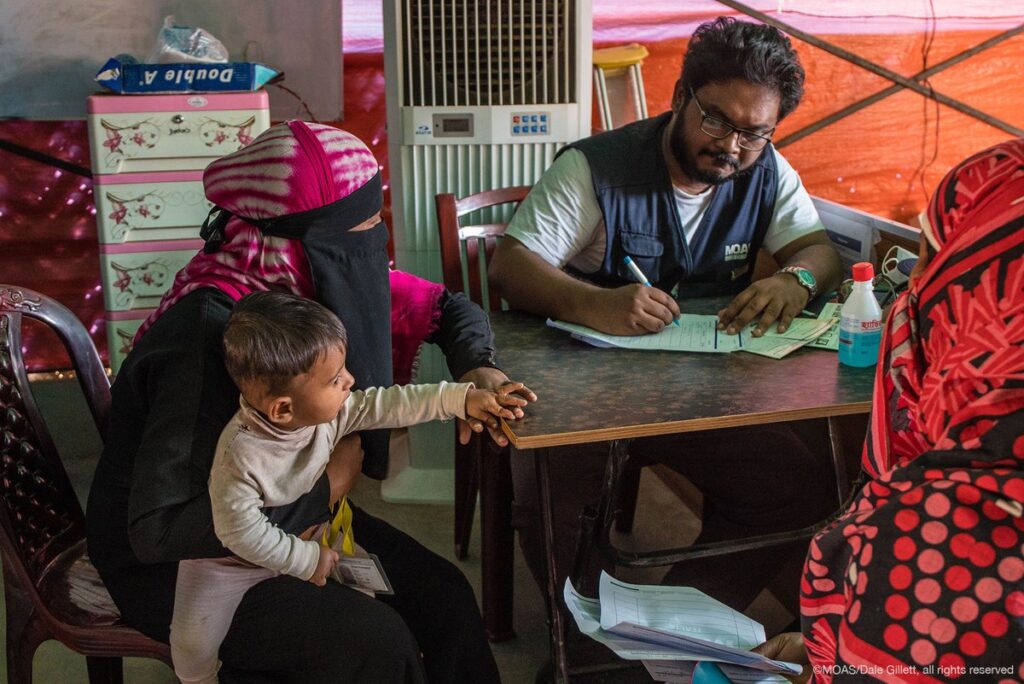2018 has been a year of both challenges and achievements. Read our end-of-year round-up to find out what we’ve been doing and what the next year will hold.
BANGLADESH
When MOAS arrived in Bangladesh in September 2017, we were one of the first NGOs to respond to the Rohingya exodus from Myanmar, sparked by an outbreak of brutal violence on August 25th. Witnessing a desperate need for medical care to alleviate the suffering of thousands who were fleeing across the border injured, traumatised and exhausted, by November 2017 we had opened two Aid Stations, or primary health centres, to serve the fast-expanding refugee population and its host communities.
To the end of November 2018, the MOAS Aid Stations in Shamlapur and Unchiprang provided vital medical assistance to over 90,000 children, women and men. Our Aid Stations stayed open year-round, were used as vaccination centres in coordination with the WHO and Bangladeshi government, and became a space of respite and comfort for Rohingya and Bangladeshis alike.
During the rainy season – between June and November – we focused on ensuring the Aid Stations were equipped to withstand high winds and heavy rains, and to treat an increasing number of patients. Every year, Bangladesh faces a cyclone and monsoon season that can bring severe flooding, flash flooding, water-logging and wind damage. In response to these threats, MOAS created mobile medical units to provide rapid-response care for people affected by landslides and floods; the teams received Flood Safety and Flood Rescue training, allowing them to cross flooded ground in safety and transfer injured people to the Aid Stations for treatment.
At the start of December, we launched our plans for new programming, developed in line with the 2019 priorities released by the Joint Response Plan for the Rohingya humanitarian crisis. Throughout the coming year, MOAS will continue to operate in Bangladesh, running training and capacity-building projects in partnership with other NGOs and agencies. Our interventions will focus on flood and landslide rescue, water safety, and the provision of services to remote or inaccessible areas. In order to safeguard the right to healthcare of all those who have come to rely on the MOAS Aid Stations, we have also finalised an agreement with the International Rescue Committee, who have taken over use of our assets and sites, and will continue to provide medical assistance in Shamlapur and Unchiprang.
ANDAMAN SEA
Just after Easter, MOAS launched an observation mission in the Andaman Sea to monitor maritime developments in the Rohingya refugee crisis. The mission was announced on April 3rd in response to confirmed reports of Rohingya attempting to flee Myanmar by sea in unsafe vessels. The MOAS team departed Galle, Sri Lanka, on April 23rd on board Search and Rescue vessel M/Y Phoenix, and concluded operations in Pulau Weh, Indonesia, on May 13th. During this time, M/Y Phoenix patrolled 2,674 nautical miles, or over 4,950 kilometres.
Having reached the intended operational area on April 27th, the MOAS team remained on 24-hour lookout for objects appearing on radar without an AIS (Automatic Information System) response. Throughout the mission, the team investigated 408 contacts, or unidentified objects, mainly using the ship’s high-powered optic systems. Most vessels of interest turned out to be small fishing boats, though some commercial and private vessels were also investigated. Rohingya are known to depart Myanmar in fishing boats, making it difficult to distinguish between genuine fishing trawlers and refugee boats.
After receiving confirmed reports that a Rohingya boat had left the coast of Sittwe, Myanmar, on May 5th, MOAS took up position at the likeliest point of encounter, based on calculations of the boat’s probable route and speed. For several days, M/Y Phoenix patrolled the area of interest in the hope of intercepting the boat and providing whatever assistance might be required. On May 11th, however, MOAS learned through local news reports that the boat had been forced to return to Myanmar the previous day due to engine failure. Two days later, Rohingya sources reported that another boat had been intercepted by the Burmese Navy and returned to Myanmar.
MOAS remains gravely concerned about the dangers faced by Rohingya refugees attempting to reach Malaysia or Indonesia by boat, and calls on the international community to urgently establish an independent maritime mission to safeguard the human rights of desperate people forced to flee violent oppression in Myanmar.
YEMEN
At the start of December, MOAS launched a new campaign to bring pharmaceutical aid, famine relief and medical care to Yemen.
An estimated 57,000 people have died in Yemen’s brutal conflict since 2015, while 3.9 million are forcibly displaced. Over 22 million civilians – 80% of the national population – are in desperate need of humanitarian assistance, but with air strikes frequent and violence spread out across the country, access lines have been severely restricted, resulting in a devastating famine. Meanwhile, with 14.8 million people unable to reach healthcare or clean water, Yemen has seen the worst cholera outbreak of modern times.
MOAS intends to stock its 40-meter vessel, M/Y Phoenix, with essential pharmaceuticals, medical equipment and specially formulated nutrition supplements. These medicines and famine relief supplements would be transported to the port of Aden for distribution to agencies in the field. In accordance with the needs of the health cluster, the M/Y Phoenix would then act as a secondary healthcare provider, focusing on emergency dental and ophthalmology treatment and using the fully equipped clinics on board.
CAMPAIGNS
MOAS continues to advocate for the creation of safe and legal alternatives to the perilous migrant journeys that claim thousands of lives each year. You can join the conversation via the hashtag #SafeAndLegalRoutes, or support our campaign by buying a MOAS t-shirt. To help us continue providing aid and assistance to the world’s most vulnerable migrant communities, please donate what you can via www.moas.eu/donate.



